Katanning Agricultural Show.
| BROOME HILL SHOW |
| SECOND BROOMEHILL SHOW |
| GREAT SOUTHERN AGRICULTURAL SHOW |
| A NOVEL SHOW |
| FIRST KATANNING SHOW |
| KATANNING AGRICULTURAL SOCIETY |
| ROYAL AGRICULTURAL SOCIETY W.A. |
The annual Katanning Show has been a feature of Katanning for over 125 years and, thanks to a small band of avid volunteers, it looks like being around for many more. The Agricultural Show has had its ups and downs over the years including two world wars, drought, hiccups to the national economy and more but has survived all of this and crowd numbers continue to grow.
The Agricultural Show actually started in Broomehill as the Broome Hill Agricultural Show in November of 1891 before changing its committee name to the Great Southern Agricultural Horticultural and Pastoral Society in 1896. However, it was still held in Broome Hill.
In 1898, E. R. Beeck endeavoured to arouse interest and get a general show but failed. Not to be beaten, he determined to have one of his own which he held in February the following year. This show proved extremely popular although he was the only exhibitor.
Despite being a drought year, the first time the Great Southern Agricultural Horticultural and Pastoral Society’s annual show was held in Katanning was 26 – 27 October 1900, following a massive summer rainfall on the Friday.
The Katanning show was originally held on land where the Katanning Aquatic Center is now located in Park Street before it moved to its current showgrounds in Pemble Street.
.
THE BROOME HILL AGRICULTURAL SHOW
West Australian
18 November 1891
The first annual show of the Broome Hill Agricultural, Horticultural, and Pastoral Society was held on November 12th at Broome Hill (later Broomehill). The show was a great success, and, in spite of the exceedingly hot weather, the town was thronged with visitors from the surrounding country, and about 200 people arrived at Broome Hill by train from Albany.
The exhibits on the whole were good. In the sheep section there were a fair number of exhibits. Horses were exceedingly good, especially in the draught class. There were six entries for the best team of four horses in wagon harness, and the judges had considerable difficulty in awarding the prize.

A 1900’s advertisement for Fitzgerald’s Circus.
There were not many entries for cattle and the poultry was inferior. Farm produce was good, and there was a good selection of vegetables and cut flowers. In the implement and agricultural machinery section R. S. Climie & Co. took most of the prizes, including the prize for the best collection.
Messrs. F. & C. Piesse’s exhibits of aerated waters and cordials also deserve special mention. This firm sent 800 dozen bottles of their cordials, etc., to the show and sold the whole lot. In the evening Fitzgerald Bros. Circus performed to a crowded house, with 982 people paying for admission.
.
THE SECOND ANNUAL SHOW
BROOMEHILL AGRICULTURAL, HORTICULTURAL AND PASTORAL SOCIETY
The West Australian
25 October, 1892
(From our Correspondent.)
The second annual show, in connection with the above society, was held on Wednesday last, the 19th inst., under most auspicious circumstances. His Excellency the Governor, Sir William Robinson, accompanied by Capt. Stuart, A.D.C, the Commissioner of Crown Lands; Stephen Henry Parker, the Colonial Secretary; and Mr. F. H. Piesse, M.L.A., arrived by the 11.45 train from Beverley, the southern special having already brought Mr. J. A Wright, M.L.C., President of the Society; Messrs. A. Y. Hassell, M.L.A., and F. T. Hassell, and other gentlemen. On arriving on the ground, the President welcomed His Excellency to Broomehill, and desired him to perform the opening ceremony.
His Excellency returned thanks for the manner in which he had been received, and in an appropriate address wished success and prosperity to the interests supported by the Society and concluded by declaring the show open to the public. Three hearty cheers for His Excellency were given, and this brought the opening ceremony to a close.
It can scarcely be said that the show exemplified to the full the increase in agricultural pursuits, as the number of exhibitors about 84, and the number of exhibits, upwards of 300, are very slightly in advance of last year ; but the arrangements were carried out in a much more effective manner, and the work done by the judges and stewards was appreciated to the full, and gave universal satisfaction. The popular secretary, Mr. J. H. Otto (and secretary of the Broomehill Roads Board), deserved special mention for the courteous and masterly manner in which he executed the many and onerous duties entrusted to him, and the society may well congratulate itself on possessing his services
The horse classes were perhaps the best on the ground, though the jumping, like that of last year, scarcely deserved that title. Some good sheep were shown, both in merinos and long wools, but the exhibits in the swine sections were lamentably few and inferior, there being indeed only one entry. The show of cattle was some improvement on last year’s though it is to be hoped the variety will materially increase in future years. The poultry class was fairly filled, various sections being represented, but competition was not strong.
Dairy produce, grain, vegetables, flowers and preserves were shown in the large show room, which is certainly a great improvement to the ground. The general appearance of the room was considerably added to by the large ornamental pagoda of aerated waters and cordials, shown by Messrs. F. & C. Piesse, Katanning, and which occupied a prominent position opposite the doorway.
The machinery exhibit was much fuller than last year, and this is very satisfactory, as showing the degree of importance attached to this most important branch.
Regarding the internal arrangements of the ground, it must be said that great improvements have been made. In addition to the show room, the pen accommodation has been greatly enlarged, and a fenced ring has been made in the centre of the ground. It must, however, be said that these rings are far too small for showing the paces of any animal.
The public were supplied with creature comforts by Mr. Wand, of Albany, assisted by a competent staff. As the weather was beautifully mild, the assertion that general enjoyment prevailed may be confidently hazarded.
It may be mentioned that immediately after the official opening, a group, with His Excellency and the other distinguished visitors in the centre, was taken by Mr. G. H. Woodleton, who also photographed various prize-takers among the livestock during the day.
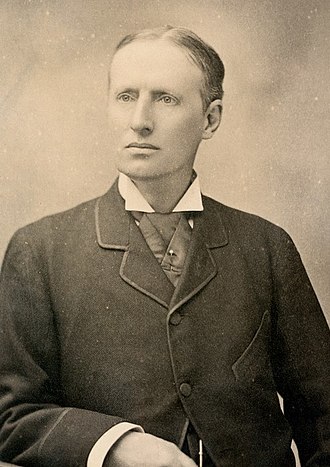
Sir William Robinson
A Special Prize given by C. R. Fenwick, Esq., for best animal exhibited by any person occupying land purchased from the W.A. Land Co. went to Mr. R. S. Taylor. Following the show there was a dinner in honour of His Excellency, Sir William Robinson.
.
GREAT SOUTHERN AGRICULTURAL SHOW
West Australian
31 October 1896
The first annual show under the auspices of the Great Southern Agricultural Horticultural and Pastoral Society was held on the grounds of the society at Broomehill on 23 October 1896. The weather was beautifully fine, the attendance good numbering over 300, and the exhibits strong in number and quality, there being over 250 altogether.
On the whole the show compared favourably with those of previous years held under the management of the Broomehill Society. This is how it should be, as the amalgamation of Katanning and Broomehill for show purposes should undoubtedly be productive of good.
.
A NOVEL SHOW AT KATANNING
The West Australian
28 February, 1899 – Page 3
On Thursday, 23 February, 1899, Mr. E. R. Beeck, of Capemont Farm, Katanning, held a decidedly successful show in the local Agricultural Hall, himself being the only exhibitor. Mr. Beeck endeavoured to arouse interest and get a general show but failed. Not to be beaten, he determined to have one of his own, which caused much comment and even adverse criticism, by the envious and jealous.
The large attendance, however, showed that curiosity overcame prejudice and that the prejudiced were far the minority. It is to be hoped that this plucky and successful effort will be the foundation of an annual show at Katanning.
The quality and quantity of the exhibits, of which there were over 80, caused, surprise and delight and should give hope and encouragement to all who are settling in the district.
.
FIRST KATANNING SHOW
GREAT SOUTHERN PASTORAL AND AGRICULTURAL SOCIETY.
TENTH ANNUAL SHOW.
THE LEADING EXHIBITS.
West Australian
29 October, 1900
The Southern District needed rain, needed it badly, and though hope is supposed to spring eternal in the human breast, it was growing very weak the in hearts of the Katanning farmers until Thursday, when a steady downpour set in, and it lasted all day Friday. It was a Godsend to the district, though there was a general feeling of regret that Providence had not been earlier, or a little later, with its beneficence, so that the first show ever held in Katanning might have had the success it deserved.
It was generally conceded that the rain has done an amount of good to the crops, which must be estimated in thousands of thousands. The regrets over the ruined show, in fact, will soon be forgotten in the greater abundance of the coming harvest.
Despite the unpropitious weather, there were some 1,200 people on the Agricultural Society’s grounds, and a sum of £45 ($90.00) was taken at, the gates. This is considerably more than was taken last year, when the society held its show at Broomehill. The improved receipts were a reflex of the all-round improvement in both the number and quality of the exhibits.
The secretary (Mr. W. E. Keetley) states that he received 700 entries this year, as against 500 last, and he has 500 exhibits now as compared with 380, a very distinct gain.
On entering the main building, the first object which arrests attention is a trophy of various products, which Mr. E. R. Beeck has raised and manufactured on his farm, a couple of miles out of Katanning. Displayed upon the shelves were hams, lard, German sausage, preserved fruits, raisins, dried fruit, dried herbs, wine, peppermint cordial, linseed, pickles, cakes, confectionery, vegetables, fruit, and flowers, a collection which showed use illimitable possibilities in productiveness of the soil. Mr. Beeck, who is of German nationality, farmed in the Murray Bridge district of South Australia for many years, but in 1892 he took up 15,000 (6,070 ha) acres at Katanning, and has resided there ever since.
Members of Mr. Beeck’s family were nearly all prize-takers in one form or another, and Mr. Beeck himself secured most of the prizes in the vegetable exhibits, as well as many others. Notably he carried off the £5 5s. ($10.50) prize Mr. F. T. Crowder offered last year for the best 5 cwt. (254 kg) of bacon as a means of encouraging mixed farming.
Mr. Vanzuilecom was the only other competitor, and though he made a creditable show, his produce was not turned out in such good exhibition order as Mr. Beeck’s. There are two remarkable trophies erected by Messrs. F. and C. Piesse in the centre of the building, one of wine and the other of flour. Both of these represent active industries in Katanning, and the quality is equal to anything in the colony.
A word of praise should also be accorded to the handsome kauri pine wardrobe which Mr. Lebad had manufactured in Katanning, but this is a high class of work, which would have better chances of success in the metropolis.
Mr. Beeck disputed with the Messrs. Piesse the supremacy for wine manufactured, but the latter secured most awards. Mr. Haynes, who came down from Perth specially to judge the wines, spoke in high terms of the soundness and bouquet of the wine, and he says with age it will be equal to the best wine he had tested at the Singleton and Dubbo shows in New South Wales. He found the light dry wines specially excellent, and he said that they gave evidence of the very favourable character of the Western Australian climate for the manufacture of wines of that class.
If the sheaves of wheat and hay shown are a fair indication of the state of the crops in the Williams district, a bountiful harvest must be looked for, for they were very strong and healthy, and the ear weft grown. Mr. Beeck exhibited a sheaf of prairie grass, which grows very readily, being very tender and sweet. He asserts the cattle prefer it to corn.
One of the most satisfactory evidences, from a farming point of view, was that there were more exhibits of butter and eggs than have ever been known before, and with the increased production there has been a very marked improvement in quality. There was not, however, a solitary exhibit of cheese.
Mr. J. J. Treasure is a difficult man to beat in the draught classes, he having so many good animals. His champion stallion, Hero’s Lad, secured championship honours for the second successive year, his great strength and compactness helping him to defeat all comers. He showed also a foal, a yearling, and a two-year-old from the Blue Ribbon mare Kate, as fine a trio of young draught colts as one could wish for. His champion mare, Black Violet, who has secured 97 first prizes in Victoria, and three in Western Australia, has been a disappointment to Mr. Treasure, in that all her foals have met with mishaps, and have had to be destroyed.
Perhaps the cattle as a class were not quite equal to those of last year. And one missed the fine pen of bullocks which then secured an award. It also seemed a pity that Ayrshires and Jerseys should have had to compete together in one class, for the result at best must be unsatisfactory. Messrs. C. and E. Millar, of Mount Barker, showed a fine lot of Ayrshires, and Mr. W. S. Ferry secured an award for a well-bred and well-proportioned Hereford bull, bred by Mr. J. H. Angas, in South Australia.
Very few pigs were shown, though it is said a great many are raised in the district, but with the price of pork as it is, as soon as the young animals attain a marketable size they are slaughtered and sent to the butcher.
Sheep were very good as a class, though not numerous, and the judges must have had some difficulty in making the various awards. The principal competitors were Warren Bros., Pallinup Estate, F. and C. Piesse, H. Brockman, and H. Quartermaine. They divided most of the prizes between them.
It was conceded on all hands that the show was far and away the most successful ever held in the South Western district, and the result is in no small measure the outcome of the unwearied exertions of the hon. secretary Mr. W. E. Keetley, whose long experience in managing shows has been a goldmine to the Great Southern Society. Unfortunately, Mr. Keetley, who is post and telegraph master at Broome Hill, is shortly to be removed to Jarrahdale, where agricultural shows do not occur, so the Great Southern district will suffer a serious loss.
Mr. F. H. Piesse and Mr. C. A. Piesse devoted themselves to attending to the visitors, and succeeded in making a dull, wet, cheerless day not only bearable, but enjoyable. The Albany brass band enlivened the proceedings by a number of choice musical selections.
.
KATANNING AGRICULTURAL SOCIETY
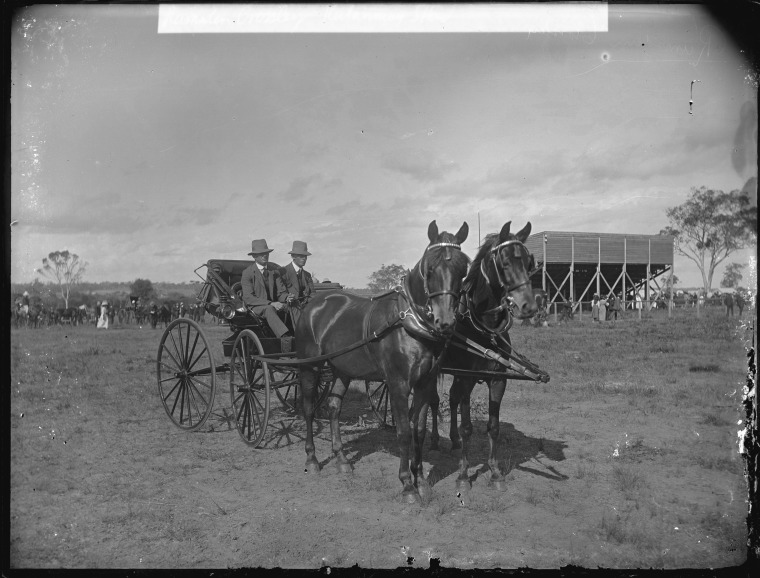
Messrs Ramsden & Crossley’s prize buggy pair
(14 hands and over) at the Katanning Show,
30 October 1912
THE ANNUAL SHOW.
The West Australian
31 October 1913
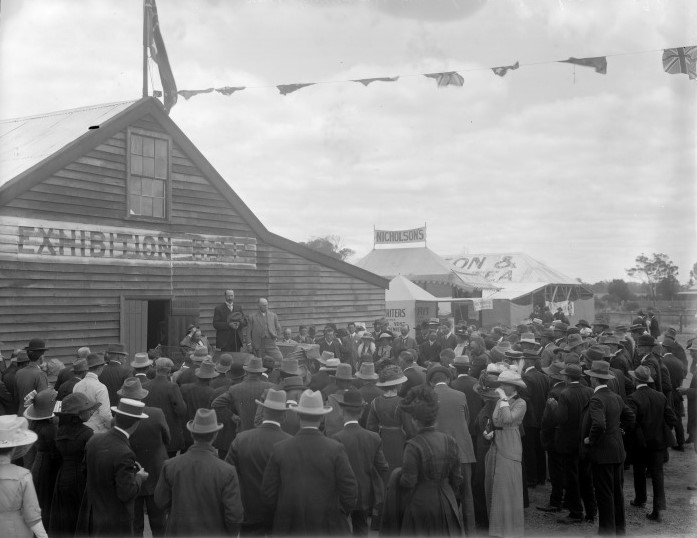
Philip Collier (Minister for Mines) opening the Katanning Show, 29 October 1913
Katanning, Oct. 29.
The annual show of the Katanning Agricultural Society, which was commenced today, is a more pretentious affair than the average agricultural carnival, and it is only fitting that it should be so, as the district is second to no other centre of the State in point of productions either in wool or in wheat. It is a two days’ show, and though the holiday does not fall until tomorrow the town is already full to overflowing.
This thriving town, with its well-kept streets, handsome buildings, and wide radius of verdant landscape makes a very pleasant resort in the springtime, and the showground would be a fine picnic place even without the attraction of those high class exhibits for which the agriculturists of the district have become famous.
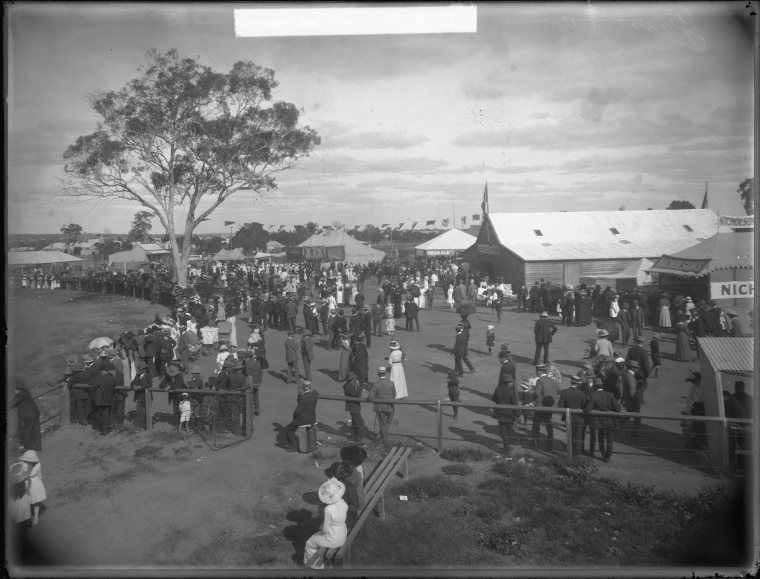
Katanning Show, 29 October 1913
The district farmers are awaiting the coming wool and wheat season with pleasant anticipations, for the indications as regards both industries are full of promise. An exceptionally good wool clip is counted upon throughout the district, and the prospects are even better than those for the wheat harvest. It is forecast confidently that the clip will be materially in advance of last year’s, and the wonderful length of some of the wool on view at the show seems to bear out the general impression.
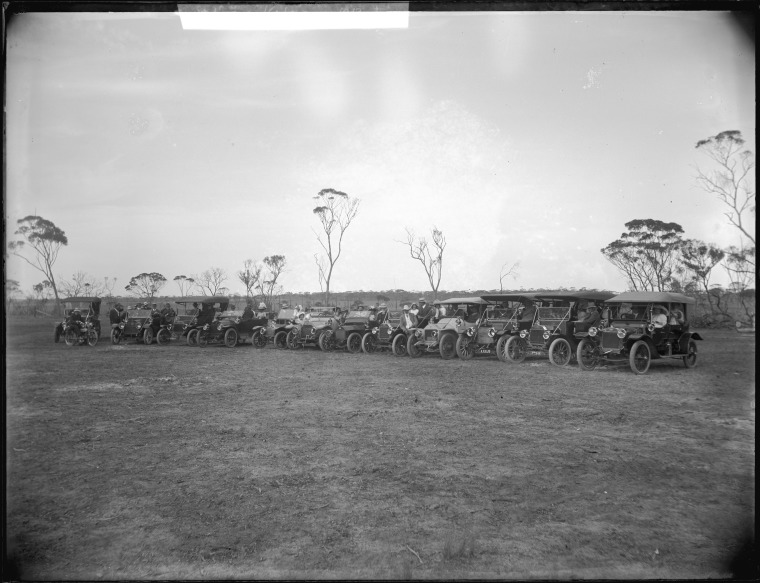
The car line up at the Katanning Show,
29 October 1913
Mr. Ross Anderson won the principal prizes for wool. The wheat harvest will probably not be so consistently prolific. East of Katanning the crops are looking magnificent. Mr. W. A. T. Sargent, of East Dumbleyung, expects a yield of four tons of hay to the acre, and Mr. P. T. James, of Bullock Hills, Messrs. Beeck Bros., Mr. A. C. Gillam, Mr. C. F. Wanke, Mr. T. Garston, and other leading growers all report good prospects. Uniformly high and rich-looking sheaves adorned the section set apart for agricultural produce. West of Katanning, however, towards Kojonup, the grain prospects are not so cheering, the district having had too much rain in August but there is a splendid grass crop to console the farmers of these parts.
The agricultural produce section also revealed that Katanning is doing well with several varieties of vegetables – onions, potatoes, and melons. The judge, Mr. F. M. Gore, expressed the opinion that farmers should go in a great deal more for onions and potatoes.
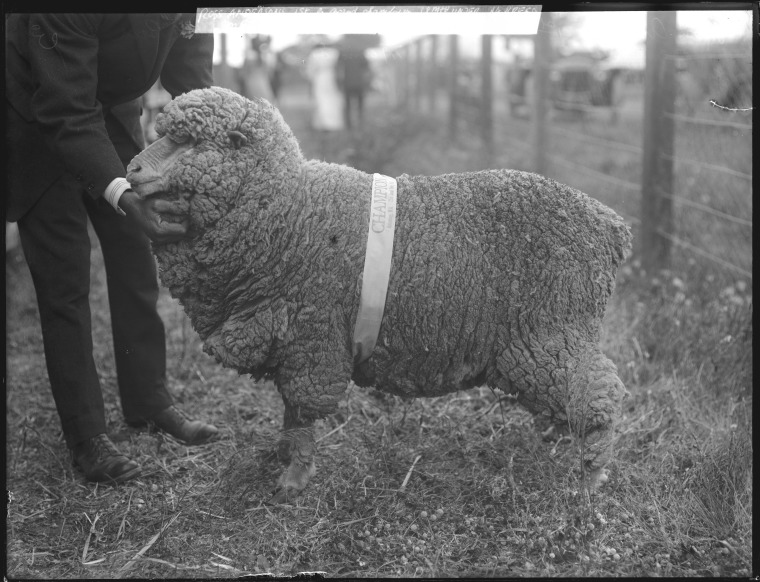
Ross Anderson’s 1st prize under 18 month old WA bred merino ewe (Grand Champion) at the Katanning Show, 29 October 1913
As far as the quantity of exhibits was concerned, the sheep section was rather disappointing, there being more empty pens than there were last year. The quality all round, however, was of a very high order and competition was good. Mr. C. Anderson won the prize for the champion ram (Western Australian bred) with a sheep which had a remarkably good covering all over. On the whole the quality of the ewes showed a falling off as compared with last year’s display, though the sheep with which Mr. Ross Anderson won the championship was a very nice animal. Mr. A. Crane showed an excellent ram which was inferior to the champion for a little less covering on the top and back.
There might have been more entries in several of the horse sections, the thoroughbred stallions and mares being instances in point. In the latter section, however, Mr. Levitzke showed a beautifully formed animal for the winning prize. This was Murina by Mural out of Trevor, an eight-year-old mare. With only one exception the exhibition of mares suitable for breeding remounts was very satisfactory.
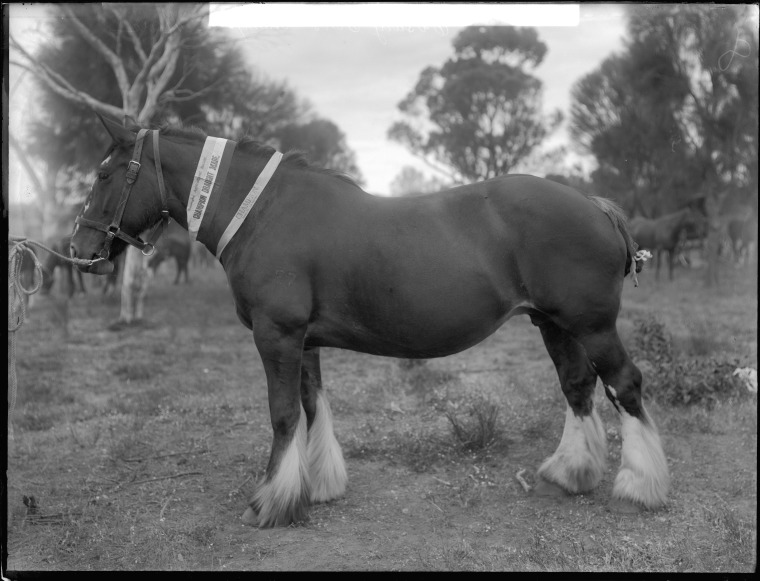
Ebsary & Sons champion draught mare at the Katanning Show, 29 October 1913
The winner, Mr. T. Russ’s Beauty, is an importation from South Australia. The judge, Mr. F. McKinnell, reported very keen competition in the trotting section, though there were only three entries. Mr. G. Beard won the prize with Wilkes B., by Osterley out of Red Rose. A beautifully topped, thoroughly formed animal named Royal Barkly, bred at Pingelly, won the open Clydesdale stallion. Among eight competitors Mr. McDonald’s Culloren, a locally bred stallion, secured the second place. The judge, Mr. T. H. Wilding, described the competition in this section as highly creditable, but declared that several of the competitors were misplaced, and should have been in the Sires’ division. The best Sire proved to be Bolson and Cowen’s Forester Boy, an English-bred horse.
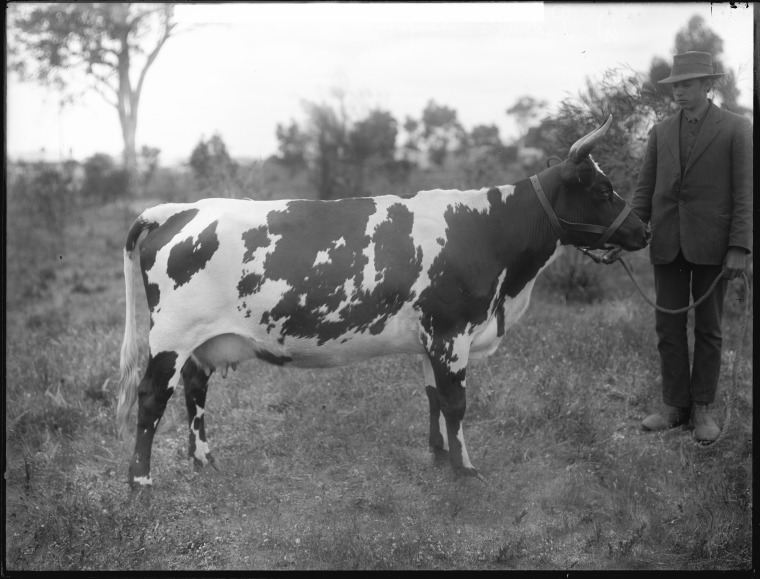
W. Padbury’s champion Jersey cow at the Katanning Show, 29 October 1913
The cattle section was noticeable for further triumphs for Mr. W. Padbury, president of the Royal Society, who carried all before him with his champion bull, and he also won with a fine specimen of a Jersey cow. A great number of the cows exhibited were, according to the judge, useful animals, but not show cattle.
Some very fair farm implements in the machinery section were exhibited in the name of Messrs. F. and C. Please, representing the Sunshine Harvester Company and the Katanning Stock and Trading Company. An interesting exhibit in this section was a pile of sand bricks. a local product, which is still in the experimental stage, but which is already being utilised for building purposes in the district. Local residents are confident that it will prove a marketable commodity.
The great attraction at the show today was an exceptionally large programme of ring events. The attendance was a record for the second day, though the gate receipts, owing to a large increase in the number of members’ tickets issued by the society, might not have shown it. All parts of the ground were thronged with family parties, and the ringside throughout most of the afternoon was uncomfortably crowded. The other events made up a very complete afternoon’s entertainment.
There were many close contests, particularly in the hunters’ sections. One of the hunters’ events, which was competed for by no fewer than ten riders, most of whom were well above the average for general horsewomanship. One girl rider aroused considerable cheering by pluckily remounting after being twice thrown. For keenness of competition and all-round merit the military sections were also interesting. All the competitors in this section belong to the local squadron, a fact which speaks well for the defence movement in the district.
.
ROYAL AGRICULTURAL SOCIETY W.A.
HISTORIC TIME LINE
OUR HISTORY
There are few institutions that can trace their origins to the first years of the Colony and fewer still can claim such a long and distinguished history as The Royal Agricultural Society of Western Australia (RASWA). The families who pioneered the State of Western Australia also founded RASWA, which was established in 1831.
View RASWA timeline
The First Official Show
In January 1834 the Society held a historic meeting where it was decided to hold an annual Show; this inaugural show was known as the “Fair and Cattle Show” and was held on 7 November 1834. According to the Society’s records at that time, the colony’s stock amounted to 307 cows, 96 working cattle, 97 bulls and steers, 3545 sheep, 492 goats and 374 pigs.
The Society Becomes Royalty
In 1890, the Governor advised that the Queen had granted permission for the Society to assume the title of “The Royal Agricultural Society” (RASWA). On 3 August 1904 RASWA became Incorporated.
The Show Moves to Claremont
In 1902, in return for land the Society held in Guildford, the State Government granted RASWA a site of 34 acres (13.7 hectares) in Claremont. An artesian bore was quickly sunk and the site was cleared and levelled at a cost of 13,000 pounds.
The first Show held at Claremont was in 1905, utilising the buildings from the old grounds in Guildford, with a newly erected Exhibition Hall and a bar. Prize money totalled 3,000 pounds and attendance topped 30,000 people. The original area granted to the Society was 34 acres (13.7 hectares) and this was later increased to 52 (21 hectares) and then 75 acres (30.3 hectares). Continue reading
Katanning Agricultural Show. Katanning Agricultural Show. Katanning Agricultural Show. Katanning Agricultural Show. Katanning Agricultural Show. Katanning Agricultural Show. Katanning Agricultural Show. Katanning Agricultural Show. Katanning Agricultural Show. Katanning Agricultural Show.
